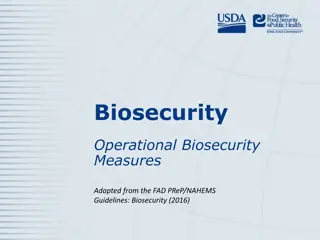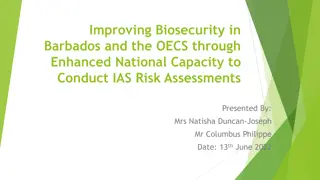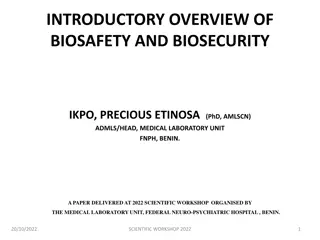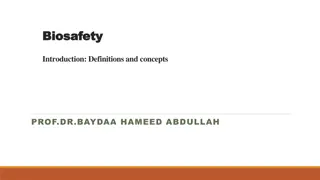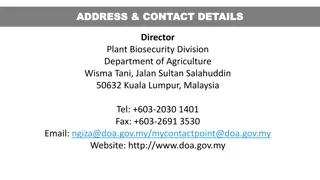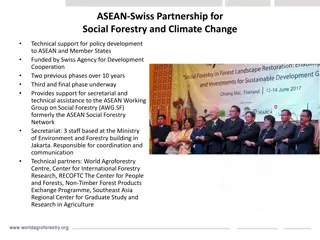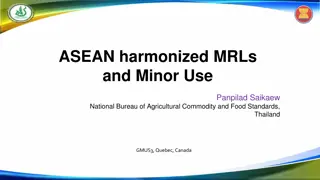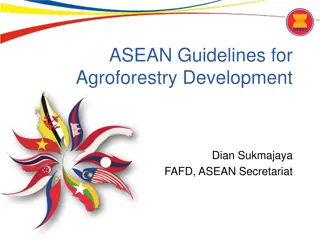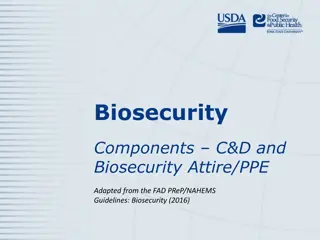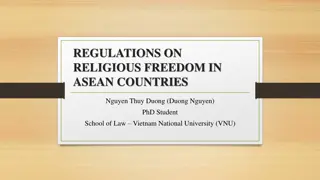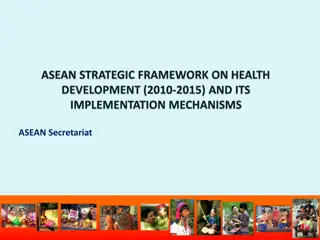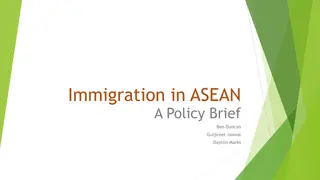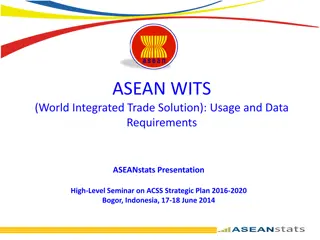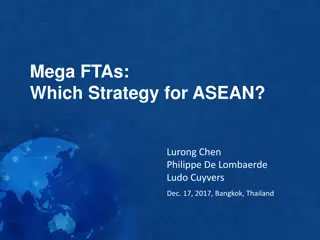Development of Life Sciences in ASEAN and Biosecurity Awareness
ASEAN countries, with a population exceeding 600 million, have invested in science and technology to transition to a knowledge-based economy. The economy of ASEAN ranks 9th globally and 3rd in Asia, showcasing strong economic growth. The ASEAN Ministerial Meeting on Science and Technology (AMMST) plays a crucial role in promoting cooperation in science and technology among the diverse ASEAN member states. Biosecurity awareness is increasingly relevant given the region's growing scientific advancements and integration efforts.
Download Presentation

Please find below an Image/Link to download the presentation.
The content on the website is provided AS IS for your information and personal use only. It may not be sold, licensed, or shared on other websites without obtaining consent from the author.If you encounter any issues during the download, it is possible that the publisher has removed the file from their server.
You are allowed to download the files provided on this website for personal or commercial use, subject to the condition that they are used lawfully. All files are the property of their respective owners.
The content on the website is provided AS IS for your information and personal use only. It may not be sold, licensed, or shared on other websites without obtaining consent from the author.
E N D
Presentation Transcript
? Overview of the development of Overview of the development of Life Sciences Life Sciences in ASEAN in ASEAN and relevance of and relevance of biosecurity awareness biosecurity awareness
ASEAN MEMBERS 1. Brunei (0.43M) 1. Myanmar (54.16M) 2. Combodia (15.68M) 2. Philippines (101.80M) 3. Indonesia (255.71M) 3. Singapore (5.62M) 4. Lao PDR (7.10M) 4. Thailand (67.40M) 5. Malaysia (30.65M) 5. Vietnam (93.39M) Total Population of ASEAN : 631.94 Million [ 2 X USA population]
ASEAN (GERD) 1. Brunei (0.12 %) 1. Myanmar (1.5 %) 2. Combodia (0.05 %) 2. Philippines (0.11 %) 3. Indonesia (0.09 %) 3. Singapore (2.26 %) 4. Lao PDR (0.04 %) 4. Thailand (0.48 %) 5. Malaysia (1.13 %) 5. Vietnam (0.19 %)
ASEAN With a population of more than 600 million people 9 percent of the world population and a combined GDP of $1.8 trillion, the ASEAN economy is ranked as the 9th largest economy in the world and the 3rd largest in Asia. The region has experienced strong economic growth with an average annual rate of 5 percent to 6 percent over the past two decades. ASEAN countries have increased their investment in science and technology to diversify from an agricultural to a knowledge-based economy.
ASEAN Ministerial Meeting on Science and Technology (AMMST) shared by the ASEAN Leaders who have recognised science and technology (S&T) as a key factor in sustaining economic growth, enhancing community well-being and promoting integration in ASEAN This task, however, is not easy as ASEAN, a grouping of ten developing countries with great variance in the level of science and technology capability, has to move the cooperation forward more vigourusly and promote deeper integration.
ASEAN Committee on Science & Technology (COST) ABAPAST: Advisory Body on ASEAN Plan of Action on Science and Technology SCB: Sub-Committee on Biotechnology SCFST: Sub-Committee on Food Science and Technology ABASF: Advisory Body of the ASEAN Science Fund SCIRD: Sub-Committee on Infrastructure and Resources Development AMMST: ASEAN Ministerial Meeting on Science & Technology SCMG: Sub-Committee on Meteorology and Geophysics ASEAN-China JSTC: Joint Science and Technology Committee SCMIT: Sub-Committee on Microelectronics and Information Technology ASEAN-India WGST: Working Group on Science and Technology SCMSAT: Sub-Committee on Marine Science and Technology ASEAN-Russia WGST: Working Group on Science and Technology SCMST: Sub-Committee on Material Science and Technology ASEAN-EC JCCSCST: Joint Cooperation Committee Sub- Committee on Science and Technology SCNCER: Sub-Committee on Non-Conventional Energy Research ASEAN COST+3: Committee on Science and Technology Plus Three SCOSA: Sub-Committee on Space Technology and Applications COST: Committee on Science and Technology
ASEAN focuses on 9 programme areas: (i) food science and technology , (vi) microelectronics and information technology, (ii) biotechnology, (vii) material science and technology, (iii) meteorology and geophysics, (viii) space technology and applications, and (iv) marine science and technology, (ix) S&T infrastructure and resources development. (v) non-conventional energy research,
Areas of Strength in Disciplines of Asean Member States ASEAN Basic Sciences Agri. & Related Sciences Medical Sciences Eng & Tech Emerging Tech (ICT, Biotech, Nanotech, Automation) - developing Brunei Combodia Indonesia Laos Malaysia Myanmar Philippines Singapore Thailand Vietnam - very strong - strong
International Comparison of R&D Expenditure as a Percentage of GDP (2012)
Research performance of ASEAN countries Malaysia has consistently increased its impact as well as shown strong output growth, reaching to a 1 percent share of the world s scholarly output in 2013. In terms of citation impact, the Philippines remains significantly above the world average but has seen some decreases through time. Vietnam and Thailand s citation impacts are both approximately around the world average. Indonesia has seen decreases in citation impact.
Agricultural & Biological Sciences is a high activity area for most countries, and a research strength for nearly a third of institutions such as Center for International Forestry West Java, Lembaga Ilmu Pengetahuan Indonesia, International Rice Research Institute. specific institutes show high impact in Medicine, such as Vietnamese Academy of Science & Technology or Mahidol University.
Good time to promote awareness on responsible science, biosecurity and pedagogy across the higher education sector of ASEAN



